- Working at KSC
- NASA Old Headquarters building on KSC destroyed.
- Flintknapping points
- Vampires of Kennedy Space Center and the O&C
- Demons of Kennedy Space Center
- Demons of Kennedy Space Center, corpus callosotomy
- Ghosts of Kennedy Space Center, End of Spiders
- Dreams of Kennedy Space Center, lovers and pyramids.
- Witches of Kennedy Space Center
- Cave Bears of Kennedy Space Center
- Aliens of Kennedy Space Center, uninvited guests
- Remembering Kennedy Space Center
- Lake 33 Killing Relic
Banana Creek
(space center gold)
Banana Creek dissects Kennedy Space Center and northern Merritt Island & once connected the Indian River Lagoon with the Banana River (and making the "island" of Merritt Island)
The race to the moon required some sacrifices and consequently Banana Creek was cut into two sections to create the gravel pathway known as the Crawlerway. (The Crawlerway connects to Vertical Assembly Building (VAB) to the Launch Pads 39A & 39B)
And of course, where needed, the Ais Indian mounds were bulldozed into the coastal wetlands to create the launch pads and Crawlerway.
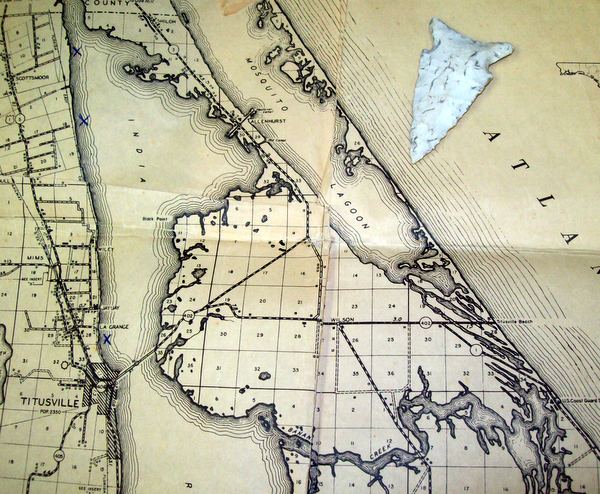
This "Pre" Kennedy Space Center map, shows Banana Creek twisting across Merritt Island (bottom center) This drawing was made before the Apollo era "Crawlerway" sealed the creek in half.
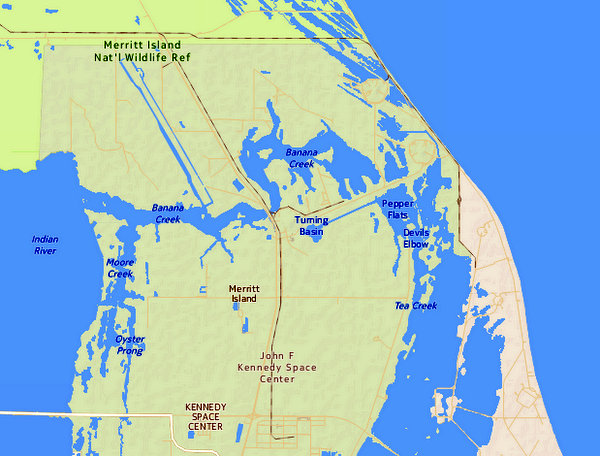
A modern drawing of Banana Creek that shows the Crawlerway, Launch Pads 39a & 39B and the Space Shuttle landing runway (upper left)
Banana Creek is currently closed to kayaking however the creek history and current use is fascinating (to me) and it is the most visited creek on Kennedy Space Center because of several special attractions:
The Mobile Launch tower being constructed along the shore of Banana Creek for NASA's new SLS rocket (The most powerful rocket ever built)
The SLS is going to ROCK the Space Coast.
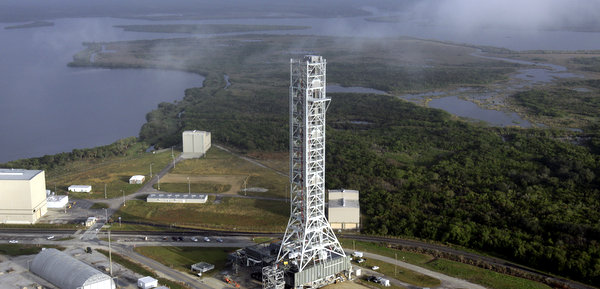
Morning fog over Banana Creek.
At 355+ feet high, the ML (mobile launcher) towers over Banana Creek. Photo Credit: NASA
Moving the Mobile Launch Tower out to Launch Pad 39B for a "Fit Test"--Excitement building on the space coast!
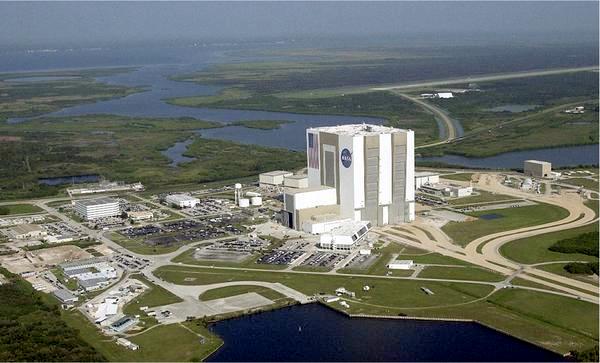
Kennedy Space Center Launch Complex 39 area.
In the background of the picture is the western entrance to Banana Creek and the space shuttle runway.
Arcos the Indian River is Titusville. Photo Credit: NASA
Brief You Tube Clip of Banana Creek Gold
As mentioned, Banana Creek is now closed to kayaking.
However at the western entrance to the creek, where the area is open to the public; boats crowd the fishing area known as "Peacocks pocket" -an almost well kept secret fishing hole. On calm days, eager fishermen ply the "Pocket" for trout, redfish & tarpon swimming from the protected waters of the Space Center.
However, if you paddle or motor into Banana Creek "you will" be arrested for trespassing. (Warning signs are clearly visible to all)
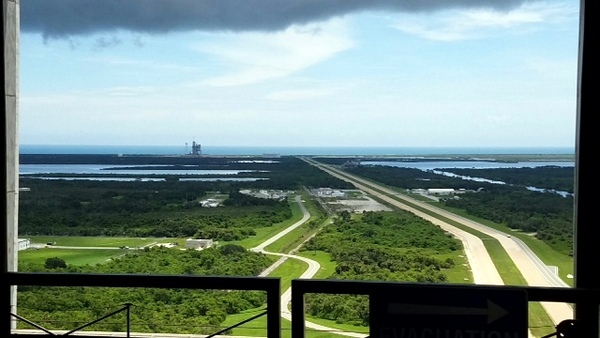
Looking out from inside the VAB doors towards the Crawlerway and the Atlantic Ocean. You can see where Banana Creek was filled in to create a path for the "Crawler" the moon rocket hauler. (Pad 39A in the distance)
Photo credit: Mine. I took the photo from the new ML/ SLS platforms.
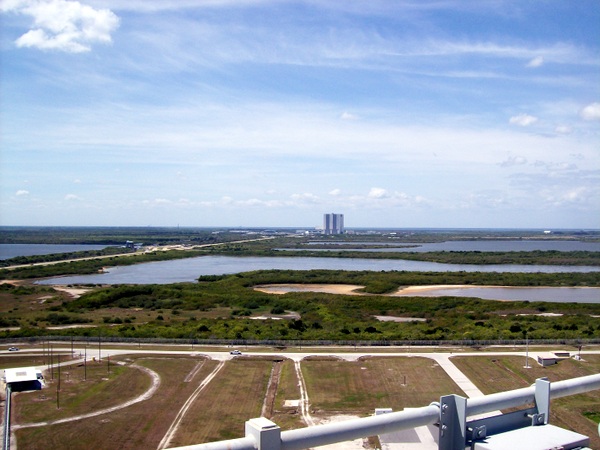
The opposite view from Launch Pad 39A (Space X pad now) shows a better view of Banana Creek and the Crawlerway that cut the creek in half.
Photo credit: Mine. I took the photo from the Pad surface which is elevated far above the Florida swamps
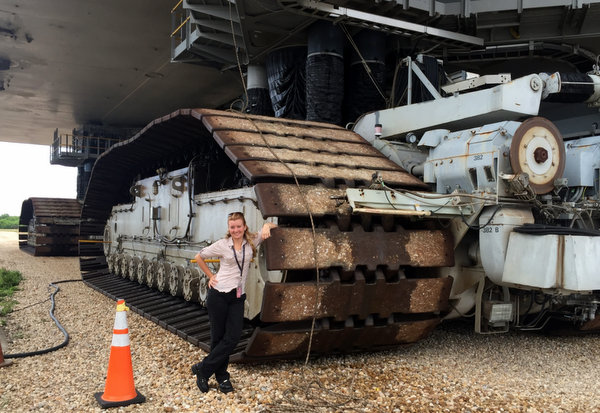
Perspective on the size of the crawler that carried the space shuttles over the filled in Banana Creek.
The crawler will carry the ML and the new SLS rocket to Launch Pad 39b
30 second video of the Crawlerway composition
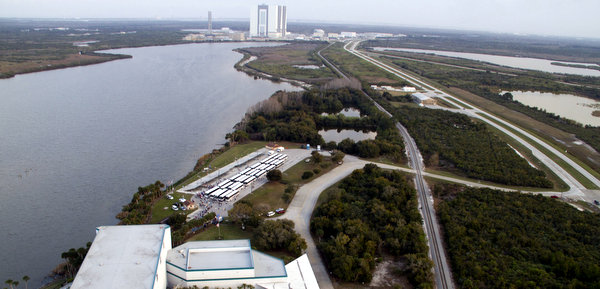
Aerial photo of "Futch Cove" on Banana Creek. In the photo is the Saturn IV building and the Banana Creek viewing site/stands. I count 39 buses parked at the viewing site!
Photo credit: NASA
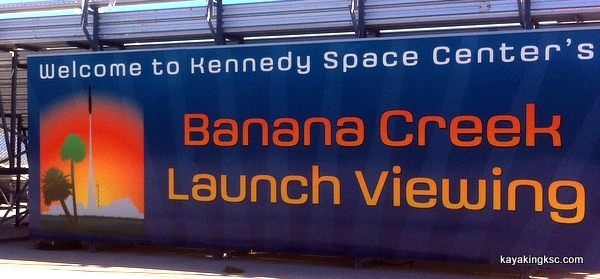
Futch Cove:
The Banana River viewing site (for VIP guests) and the Apollo building are built on the west bank of this twisting creek on a bend known as Futch Cove. The viewing stands and the Apollo building were constructed directly on top of the largest Native American site on Kennedy Space Center (Ais Indian town ghosts get no respect)
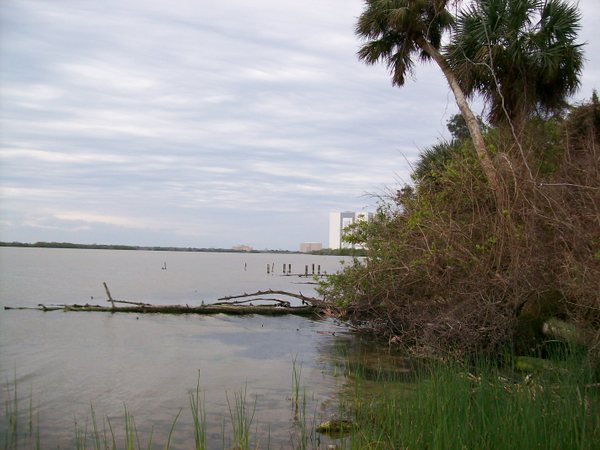
View of Futch Cove from the viewing site looking into Banana Creek. The remains of an old dock are still standing-reminders of the forced eviction of the residents of North Merritt Island to create the space center.
Photo: mine
Native Americans of Banana Creek
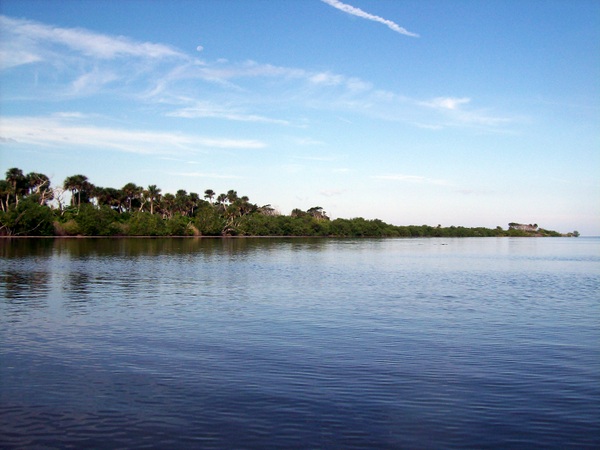
Ais Indian mound on the west section of Banana Creek
Photo Credit: Mine: I took the photo while working on the south end of the space shuttle runway.
The Ais Indians of Banana Creek. Mounds middens and portages.... Banana Creek can boast of both the largest Indian mound remaining on Kennedy Space Center and Futch Cove is the largest area of artifact debris.
Happy Creek, a branch of Banana Creek was also one of the three native American portages on North Merritt Island used to carry canoes to the Mosquito Lagoon.
Like Sykes Creek on southern Merritt Island, Banana Creek is a sheltered location from the fierce storms that sweep the Indian River Lagoon at all times of the year. (not just Hurricane season)
Consequently the Largest shell midden on Kennedy Space Center is located on west Banana Creek, directly opposite of the end of the space shuttle runway. Shuttle Astronauts returning from orbit would glide directly over this piece of old Florida on their return to gravity.
Space trivia: The Sierra Nevada 'Dream Chaser' will also land on the shuttle runway, gliding over this Ais Mound(I like the concept of past and future-it stirs the imagination)
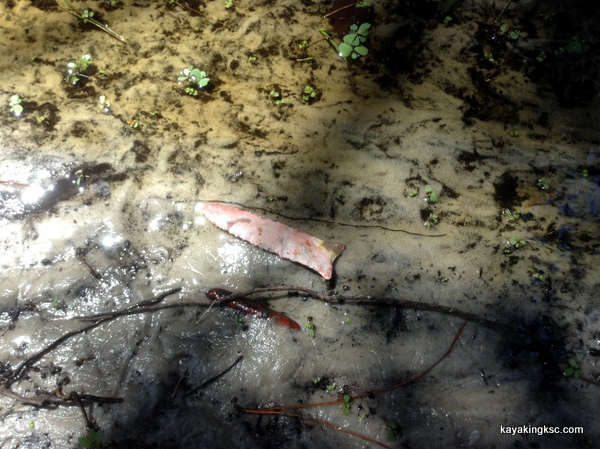
Hurricane Irma exposed a "pre Ais Indian" artifact.
I suppose I can be accused of reading too much useless information however I did note a few items recorded about Banana Creek:
The naturalist William Bartram in 1774 in described Banana Creek as having "Clear flowing water with oyster beds"
The cartographer Álvaro Mexía in 1605 described the mound on (modern day Banana Creek) as being the capital of the Northern Ais clans (however he writes that Ulumay on Sykes Creek was the largest town.
As mentioned on another page, I obtained from the local library the pre-WWII book of when Smithsonian dug up the Banana Creek mound and recovered silver artifacts. (gold was mysteriously missing) Fascinating book if you are into old school archelogy "Tomb raiding-Dig here style" before archelogy became a real science.
So anyway, I read this book and then had the absolute pleasure to visit the same Ais midden mound on the south shore of Banana Creek.
I was assigned to assist in repairing the cabling to the PAPI lights (shuttle landing lights) and my lunch hours were used judiciously to observe this mound.
Upon first look I was disappointed that the Smithsonian had not back filled their exploration (raiding) pits, as the mound is still pock marked with holes.
Spanish Buried treasure on KSC
But then I recalled; as mentioned on the Sykes Creek page, when I was first stationed to the Cape in the USAF, I took an archelogy course at the local college taught by Archeologist Bud Knoderer.
Dr. Knoderer loved to recount that in the 1960s as the space center was being constructed: that the Chief of Security for NASA dug into every mound on the space center and eventually sold his GOLD recovered from burial mounds for $8000.00 (in 1968 gold values that works out to him selling 20 pounds of gold. If I did the math correctly that would be around $315,000 in todays value) -- I would hope it would be worth the prison time.
Note: if Álvaro Mexía was correct is identifying the cacique (king) as living on the Banana Creek mound, it would only make sense that treasure found along the coast went to the king and was consequently buried in the West Banana Creek mound.
Anyway this KSC Security Chief did not bother to backfill his theft pits. And that makes me angry. It's one thing to be a thief, but a sloppy thief????? No respect. (Even the State of Florida after destroying Turtle mound for the shell, eventually rebuilt it out of shame)
Photos of treasure from the State of Florida collection
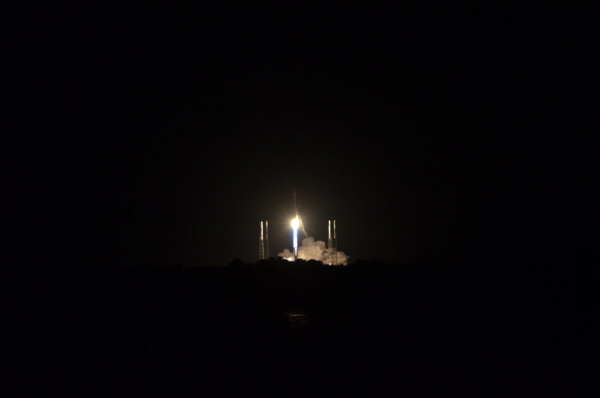
SpaceX launch as seen from Futch Cove
(Banana Creek viewing site)
Photo: mine
Back to Banana Creek......
West Banana Creek: Biggest shell mound on KSC
Futch Cove of Banana Creek: Largest native American habitation site on KSC (The Futch cove area had room to expand, while the West Creek mound is located in a mangrove swamp and the Ais Indians could only build "up")
Happy Creek Burial mound:
Paddle around the bend from Futch cove and you reach the Happy Creek branch-even more sheltered than other locations and the land around Happy Creek is higher than other parts of Banana Creek.
In the 60's a burial mound-(not just a midden) was bulldozed to build the current 250 meter tower and supporting guy wires, located on the east side of Happy Creek. Pottery shards can still be found beneath the tower. My guess is the high land around Happy Creek was the burial location for both communities of Futch Cove and the west creek midden.
(Like I said, the Ghosts of the Ais get no respect)
Alas the burial mound is gone, Futch cove is developed for space center tourists; so the Happy Creek portage is what catches my attention nowadays:
From Happy Creek it is approximately 3000 steps to one of the feeder streams to Max Hoeck Creek/Mosquito Lagoon. Any easy walk for a twenty or so Ais carrying a boat.
In Conclusion, Banana Creek is like other areas of the space coast: the past is not really past & in fact, past, present and future blend to fulfill the old proverb: "May you live in interesting times"
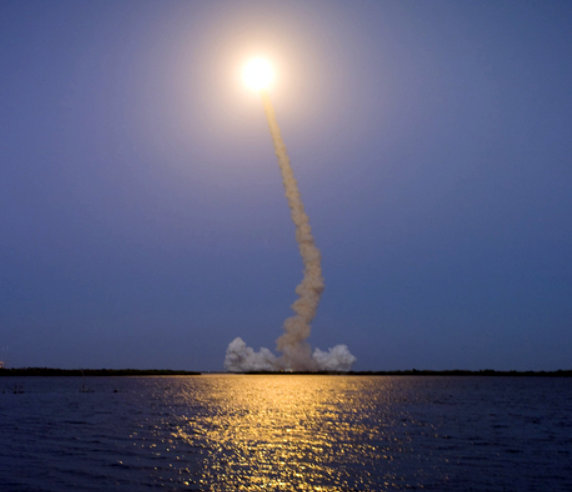
Night launch as seen from Futch Cove
(Banana Creek viewing site)
Photo Credit: NASA


Return Home from Banana Creek page
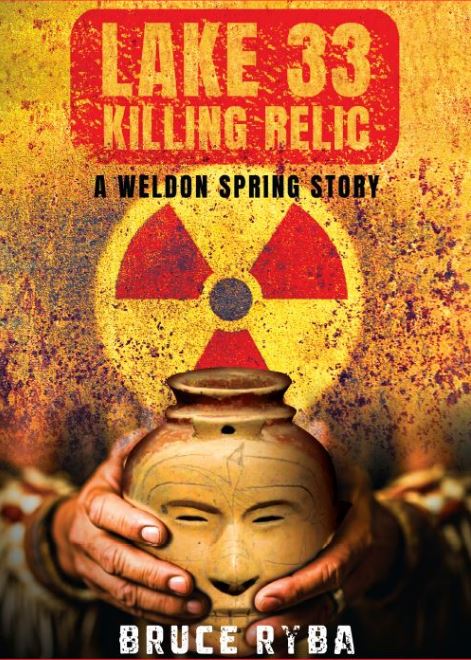
My newest book, available on Amazon
(paperback and e-book)
For pet lovers around the globe, "It's a Matter of Luck" is a collection of heart warming stories of horse rescues from the slaughterhouse.
Available on Amazon
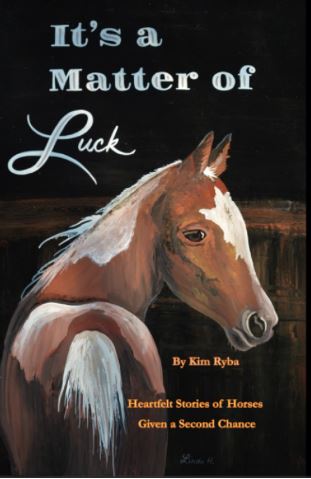
It's a Matter of Luck: Inspirational, Heartfelt Stories of Horses Given a Second Chance.
by Kim Ryba & Lina T. Lindgren
Warning: This book may cause your eyes to water in a good way. (speaking from experience after reading it)
Please give Kim and Lina a heartfelt review on Amazon!
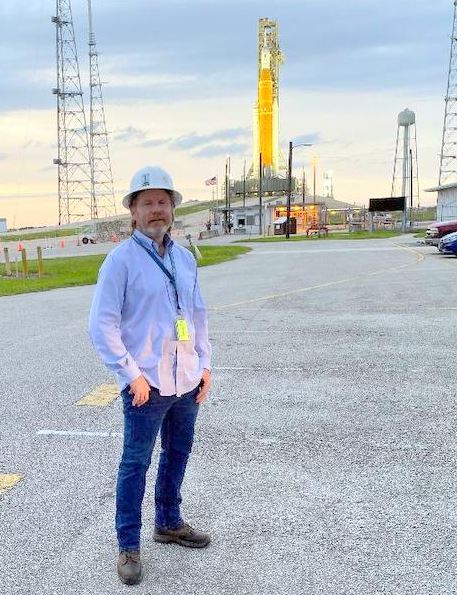
Author Bruce Ryba at Kennedy Space Center Launch Pad 39B & Artemis 1. "We are going to the Moon!"
Author's discussion (that's me) on You Tube of a book review on Amazon
For the video versions of information, please check out my YouTube Channel (Turkeys, Flintknapping, dive stories etc.)
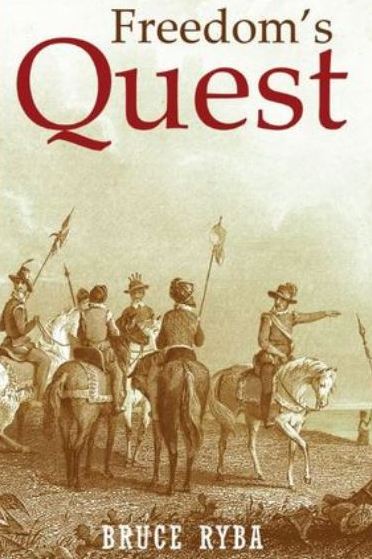
My fictional series/stories on Florida history:
Freedoms Quest (book one)
Struggle for the northern frontier and other lost tales of old Florida.
Available on Amazon
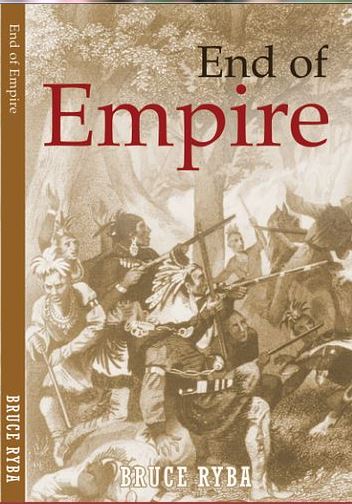
Desperate times call for bold action.
In a desperate move to retain Florida and protect the treasure-laden galleons on their dangerous return journey to Europe, the King of Spain issues a royal decree offering refuge to all English slaves who escape Florida and pick up a musket to defend the coquina walls of Saint Augustine.
In another bold gamble, the King offers refuge to the dissatisfied Indian nations of the southeast who will take up arms against the English.
Clans, traumatized by war and disease, cross the Spanish Frontier to settle the cattle-rich land and burned missions of Florida.
Follow the descendants of the conquistador Louis Castillo in remote Spanish Florida, a wild and swept by diseases, hurricanes, and northern invasions.
Book Two: Available on Amazon!